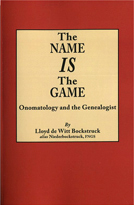 Two hundred years ago no parent would have named a child for a favorite movie star. There were no movies. However, naming a child for an historical figure, like George after George Washington, was not uncommon. Other naming practice common in the past would seldom be considered today. However, understanding such practices may help a genealogists better identify their ancestors. For example, using an uxornecronym. An uxornecronym is a name given to the first daughter born into a marriage were the name honors a previous wife. Such practices would be less common in a society were divorce is the primary reason for having previous marriages, but not so in a time when death, especially in child birth, would have left an empty place in a home to be filled by a second marriage. Genealogists looking to better understand and trace their ancestors by their names may benefit greatly from The Name IS the Game: Onomatology and the Genealogists, a new book by Lloyd de Witt Bockstruck.
Two hundred years ago no parent would have named a child for a favorite movie star. There were no movies. However, naming a child for an historical figure, like George after George Washington, was not uncommon. Other naming practice common in the past would seldom be considered today. However, understanding such practices may help a genealogists better identify their ancestors. For example, using an uxornecronym. An uxornecronym is a name given to the first daughter born into a marriage were the name honors a previous wife. Such practices would be less common in a society were divorce is the primary reason for having previous marriages, but not so in a time when death, especially in child birth, would have left an empty place in a home to be filled by a second marriage. Genealogists looking to better understand and trace their ancestors by their names may benefit greatly from The Name IS the Game: Onomatology and the Genealogists, a new book by Lloyd de Witt Bockstruck.
What is Onomatology? Where etymology is the study of the origin and history of words, onomatology is the same for names. Bockstruck explains, “onomatology is the study of names. It involves both forenames, commonly called first, second, or middle names, and family names or surnames. It also includes nicknames and place names which in the United States are often named for individuals.” He also makes the important distinction, “the study of onomatology is one based on records over centuries and requires an awareness of a multitude of changes in names.” This book provides, at least, the basics of onomatology for genealogists.
The Name IS the Game is broken into five chapters. The first acts as introduction. The second and third chapters examine given names and surnames, respectively. These chapters represent the bulk of the book and cover all types of naming practices over centuries of Europe and the United States. The last two chapters cover toponyms, place names, and provide a selected bibliography for further reference.
I have provided, below, and expanded table of contents. The list should demonstrate just how much this book covers, especially regarding surnames.
Table of Contents (expanded)
Chapter 1 Introduction
Chapter 2 Forenames
- Ethnic Clues in Forenames
- Forename or a Title
- The Maiden Name of a Mother as a Forename
- Forename Clues
- Diminutives
- Diminutive Abbreviations
- Forename Equivalents
- Multiple Forenames
- Uxornecronyms
- Ambisexual Forenames
- Postponing the Bestowing of Forenames
- Repetition of Forenames
- Forename Clues
- Hagiographic Forenames
- Naming Patterns
- Optical Mis-recognition
- Forenames from Historical Figures
- Initials
- Renaming of a Living Child
Chapter 3 Surnames
- Maiden Names
- Spelling Fixation
- Surname Confusion
- Misinterpretation of Letters of Surnames
- The Un-aspirated Initial Letter of Surnames
- Pronunciations
- The Terminal “G”
- Nee, Alias, and Genannt
- Adoption of a Step-parent’s Surname
- Military Influence on Surnames
- From English to Another Language
- From One European Language to Another
- The Dit Name
- Dialects and Minorities
- Dutch Surnames
- Abbreviations of Surnames
- The Crossed Tail of the Letter P
- The Long “S”
- The Female Title of Mrs.
- Idem Sonans
- Translation into English
- Surname Shortening
- The Letters “R” and “L”
- “Ou” and “Wh”
- Gender and Surnames
- Ethnic Clues
- Statutory Changes
- District and County Court Changes of Names
- Multiple Independent Appearances
- Spanish
- African-American
- Jewish
- American Indian Surnames
Chapter 4 Toponyms
Chapter 5 Selected Bibliography of Legal Changes of Names
Copies of The Name IS the Game: Onomatology and the Genealogist are available from Family Roots Publishing.